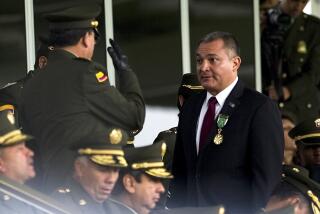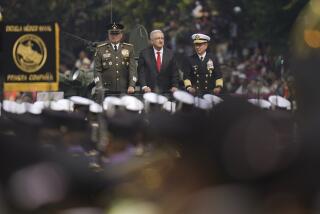After ‘El Chapo’ arrest, focus turns to next Sinaloa drug boss
MEXICO CITY — With the arrest of Sinaloa cartel boss Joaquin “El Chapo” Guzman, the leadership of Mexico’s largest and most sophisticated illegal drug operation has probably transferred to Ismael “El Mayo” Zambada, a 66-year-old former farmer with a knack for business — and maintaining a low profile.
But Zambada is likely to discover, much as Guzman did, that inheriting the throne of top capo comes with a series of complications worthy of a Shakespearean king.
Like his predecessor, Zambada is a country boy made good who hails from the badlands of Sinaloa, the traditional heart of Mexican drug-smuggling culture. Though he has enjoyed less publicity than Guzman, he has long been considered a high-level target for U.S. and Mexican authorities, who have managed to nab a number of his family members and close associates in recent years. Now that pressure is likely to increase substantially.
As long as Zambada remains free, however, close observers of the Mexican drug world will be analyzing the little that is known about his style in an effort to divine the future for his global drug empire. They will also be attuned to Zambada’s personal history — particularly his longtime business alliance with Guzman. The current state of that partnership could be the difference between a smooth succession within the Sinaloa cartel and a bloody fracturing of what has long been a loose-knit and volatile confederation of killers, smugglers and outlaws.
A U.S. federal law enforcement official said Friday that American authorities were watching Mexico closely, expecting that Guzman would be handing the reins of the Sinaloa cartel to his “most trusted” confederate.
“But the question is: Does he want it?” said the official, speaking confidentially because there is a pending criminal case against Zambada. “Does he want to become the lightning rod by becoming the head of the cartel? If he does that, he knows the U.S. and Mexico will come after him like an avenging wind.
“But he’s probably got no choice. Chapo, through his lawyers, will send a message to El Mayo that he has to take over the cartel, simply because he’s the only guy there for a smooth transition.”
In a 2010 interview with the weekly Mexican newsmagazine Proceso, Zambada, whose nickname is a diminutive often given to boys named Ismael in Sinaloa, said that he and Guzman “are friends, compadres,” who “talk on the phone regularly.” The two men do seem to have much in common. They are of roughly the same generation (Guzman, officials say, is either 56 or 59), grew up poor in rural Sinaloa, and both sport cowboy-style mustaches.
Both men have also spent decades in the drug business, the reason the U.S. government issued individual rewards of up to $5 million for information leading to their capture. Zambada is said to have begun at age 16 — “since before Christ resurrected Lazarus,” Michael S. Vigil, the U.S. Drug Enforcement Agency’s former chief of international operations, said in an interview Friday.
Early on, Vigil said, Zambada worked the Mexicali area, lording over the region against rival drug smugglers. “He killed several individuals that were trying to take over that plaza,” Vigil said.
Eventually, Zambada and Guzman formed a bond. In 1989, they were said to be among the emerging cartel leaders who were granted control of key geographical sectors of Mexico by Miguel Angel Felix Gallardo, a powerful capo of the era known as “El Padrino,” or the Godfather. At the time, Felix was seeking to disaggregate the drug trade’s leadership, making it more difficult to police.
According to federal grand jury indictments filed in 2008 and 2012 against Zambada, Guzman and others, the two men came to control two distinct and powerful factions in the Sinaloa cartel. Prosecutors said they continued their alliance in order to more effectively coordinate massive shipments of cocaine and heroin to U.S. markets, employ squads of assassins and threaten violence against buyers in the United States who dared to consider doing business with the competition.
In Mexico, there were rules, but Guzman, in particular, was happy to break them. On the website of the Mexican newsmagazine Nexos last week, Guillermo Valdes Castellanos, the former director of the Mexican government’s Center for Investigation and National Security, said that the 1989 meeting with El Padrino established dues that regional drug chiefs would have to pay to move through another’s territory.
Guzman frequently ignored these territories in his quest for expansion — one reason why Mexico saw so many battles break out in key nodes on the drug route, including Tijuana and Nuevo Laredo. Now, Valdes argues, it is Zambada who will have to decide whether to continue with the same adversarial approach.
“Everything indicates that El Mayo Zambada will stay at the front of the organization. What’s less clear is whether, with the detention of Guzman Loera, his business model will come to an end,” Valdes wrote, referring to Guzman by his full surname.
Little is known about Zambada’s management style. Writer Malcolm Beith, in his 2010 book, “The Last Narco,” credited him with a sophisticated business acumen, saying he was careful not to flood the U.S. market with drugs and thus drive down street prices.
One U.S. law enforcement official Friday described Guzman as “the muscle” at the top of the Sinaloa organization and Zambada as all the rest. “He is everything,” said the official, who asked to be unnamed because of the pending criminal charges. “The brains. The logistics. Security. Everything.
“He’s very respected in the Sinaloa cartel and even among their rivals. They respect him because he is one of the old drug traffickers in Mexico, and he’s also very feared because, like Chapo, he will exert violence. Not in a wholesale manner. He’s a little more surgical. Because he knows it’s bad for business.”
The Zambada faction and what remains of Guzman’s faction may still be close. But there is also a possibility that one may have betrayed the other, a not-uncommon occurrence in the Mexican drug world. A few days before Guzman’s Feb. 22 arrest, Mexican authorities had carried out operations that led to the arrest of a number of Zambada’s closest associates.
Two of Zambada’s sons are in U.S. federal custody, awaiting trial on drug trafficking charges. One of them, Jesus Vicente Zambada, has argued in court documents that he should be immune from prosecution because he was cooperating with U.S. officials.
The U.S. law enforcement official who spoke of the potential “avenging wind” said he doubted that either Guzman or the Zambadas rolled over, arguing that the relationship between the two clans was too strong, and that revenge could be extracted on an informant, even within prison walls.
That will do little to stem speculation in and outside Mexico.
“We’re like ships on the water, watching the bodies floating to the surface,” said David Shirk, a global fellow at the Wilson Center’s Mexico Institute. “We have no idea what’s going on below.”
Zambada’s 2010 interview with Proceso was a rare moment when he stepped into the spotlight. Zambada himself requested the interview and posed for a picture with the writer. He ended up on the cover, in an eggplant-colored Izod shirt and a hunting cap, looking defiant and a little paunchy.
In the story, Zambada bragged of his extensive knowledge of the Mexican backcountry, where he often hides from authorities. He has never been apprehended, in marked contrast with Guzman, who was arrested in 1993, and then made a high-profile escape from a Mexican federal prison in 2001. The jailbreak made him as famous as any soap opera star.
After his escape, Guzman was known for making occasional flashy appearances at crowded restaurants. That is not the case with Zambada, which may make him tougher to track. Vigil, the ex-DEA official, said that Zambada may also have had plastic surgery to alter his appearance.
“‘El Mayo’ Zambada lives in his natural environment, which is the sierra.... That’s his home,” said Gustavo Fondevilla, a security specialist at Mexico City’s Center for Research and Teaching in Economics. “It’s not the traditional model of the narco we’re used to — visible, with high levels of consumption.”
Nor is he likely to surrender. In the Proceso interview, Zambada was asked whether he would commit suicide if he was ever caught.
“I want to think,” he responded, “that yes, I would kill myself.”
Fausset reported from Mexico City and Serrano from Washington. Cecilia Sanchez of The Times’ Mexico City bureau contributed to this report.
More to Read
Sign up for Essential California
The most important California stories and recommendations in your inbox every morning.
You may occasionally receive promotional content from the Los Angeles Times.











